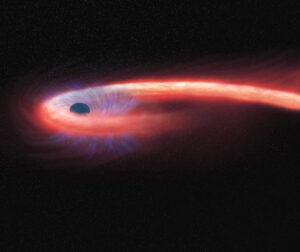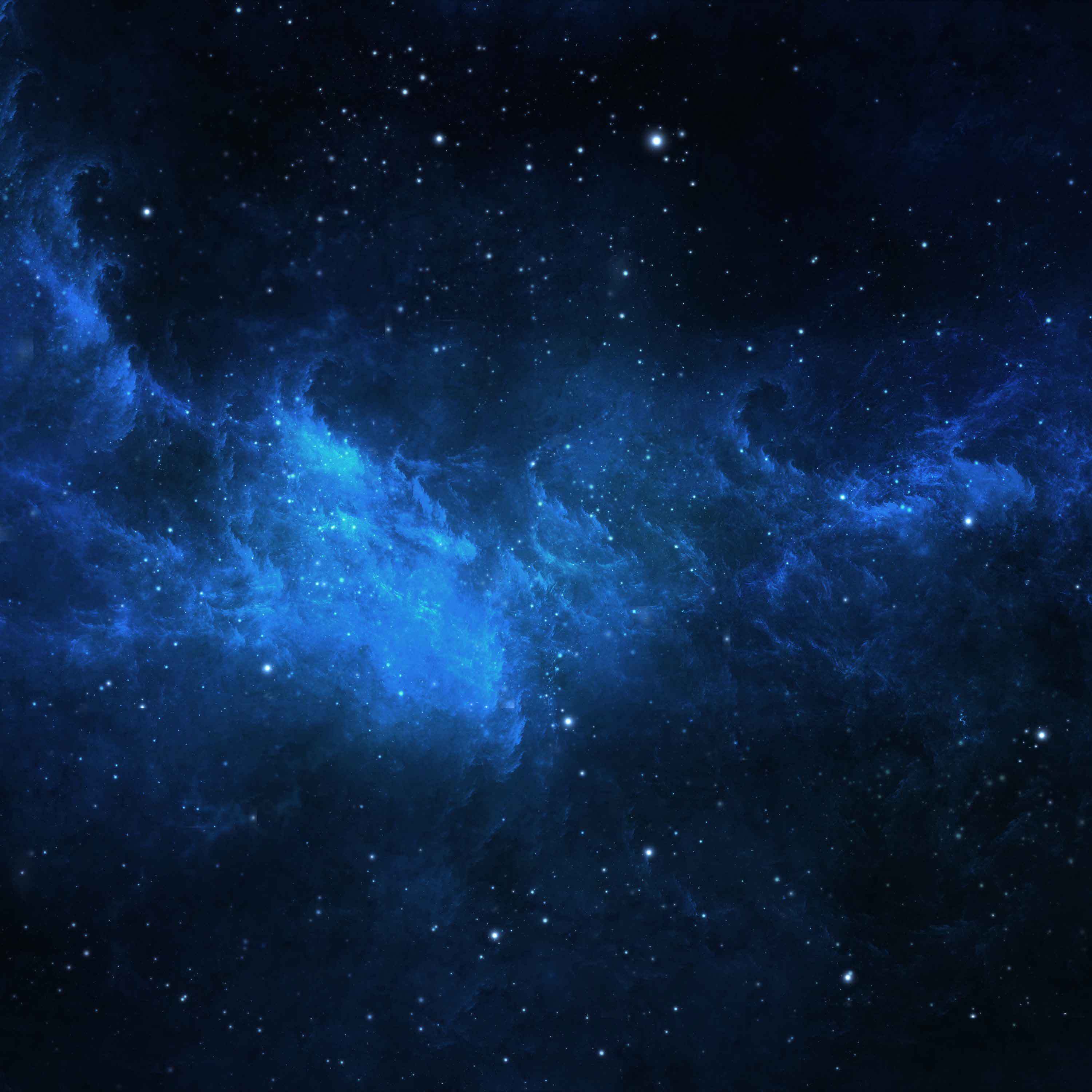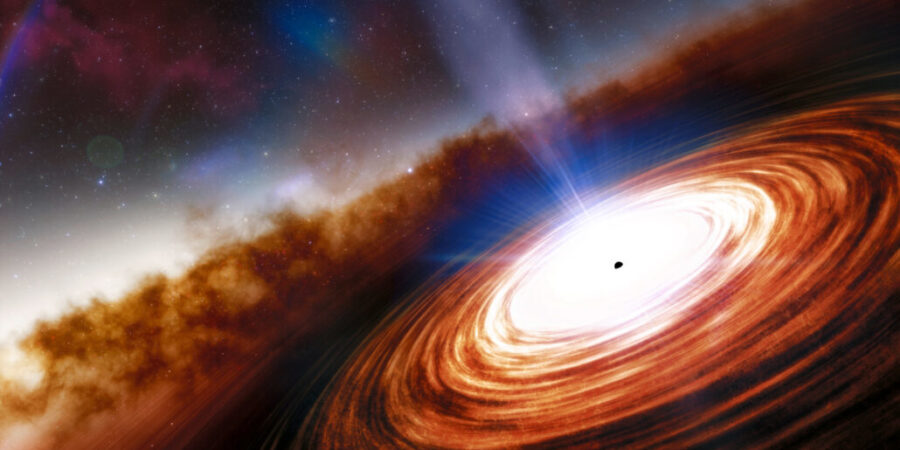
All massive galaxies are thought to harbor a supermassive black hole (SMBH) at their center, weighing in at millions or even billions of times the mass of our Sun. SMBH depending of the quantity of matter on their vicinity are called either dormant (quiescent) for extremely low or absent accretion rates (e.g., Sgr A*, at the center of our Galaxy), or active (active galactic nuclei, AGN) for low to very high accretion rates.
-
Active Galactic Nuclei (AGN): X-rays studies of accretion and ejection processes
AGN, about 10% of all galaxies, are the most persistent brightest astrophysical sources in the Universe and their peak activity occurs at about a redshift of ~2-3. Their electromagnetic emission mainly originates from an accretion disk around the SMBH and in some cases material can be expelled in the form of relativistic jets and/or winds.
X-ray observations are ideal to probe the inner part of AGN. In this framework, we use observations of complementary X-ray space-based missions: XMM-Newton (ESA), Chandra, NuSTAR and Swift (NASA) to perform spectral and timing analysis of these objects.
The accretion very close to the SMBH occurs mainly in the form of a cold accretion disc (peak emissivity in the UV) with a hot corona (T~10^9 K) located above it. X-ray observations allow us to probe the physics, geometry and dynamics of the matter in accretion or in ejection from the inner part of the disc-corona system. Moreover, theoretical works have shown that the distribution of SMBH spin is the signature of galaxy merger impact and of SMBH accretion mode (continuous versus chaotic). Since the measure of the SMBH spin is dependent on the physical model applied, it is crucial to determine the dominant X-ray process at work first (Comptonization versus relativistic reflection on the disc). To perform such studies, we apply state-of-the art modeling that takes into account the different physical processes and the geometry of the disc-corona system.
In about half of AGN (radio-loud and radio-quiet), absorption signatures in the X-ray spectra, near 8-10 keV, have revealed the presence of ultra-fast outflows (v~0.1-0.3 c) that are supposed to be relativistic winds ejected in the inner part of the disc-corona system. Their energetics appear to be sufficiently large to impact the host galaxy and are then strong candidates to explain the tight relationship between the SMBH masses and the properties of the bulge of their host galaxy (mass, luminosity and stellar dispersion). Their studies are therefore of great importance to understand the feedback process between SMBH and their host galaxy, and galaxy evolution in general.
In the near future, the launch of calorimeters on board of XRISM (JAXA, 2023) and Athena (ESA/L2, 2034) will revolutionize the domain of X-ray spectroscopy allowing unprecedented plasma diagnostics in AGN but also for numerous types of objects from stars to galaxy clusters.
This artist’s impression shows the surroundings of the supermassive black hole at the heart of the active galaxy NGC 3783 in the southern constellation of Centaurus (The Centaur). New observations using the Very Large Telescope Interferometer at ESO’s Paranal Observatory in Chile have revealed not only the torus of hot dust around the black hole but also a wind of cool material in the polar regions. [credit: ESO/M. Kornmesser].
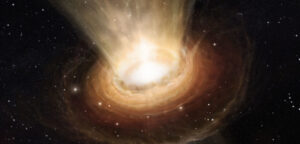
-
Multi-messenger studies (gravitational waves, neutrino and cosmic-rays)
- AGN as possible site of production of neutrinos and cosmic-rays
Blazars are AGN that exhibit a bright radio core and a large relativistic jet pointing towards the Earth, where powerful cosmic ray acceleration may occur to ultra-high energies. Their spectral energy distribution is characterized by two components: a low-energy one from radio to X-rays and a high-energy one from X-rays to very high-energy gamma rays. The low-energy component is generally attributed to synchrotron radiation in the relativistic jet by a non-thermal population of accelerated electrons and positrons; while the origin of the second component is still debated. In the leptonic scenario, the second component is due to inverse Compton process between the electrons and a low-energy photon field (their own synchrotron radiation, or external photons), while in the hadronic scenario, it originates from synchrotron emission by protons and secondary particles where the decay of the charged pions gives rise to a correlated neutrino emission.
In this framework, inside a close collaboration with CPPM (Marseille), we investigate the possible relationship between the detection of neutrinos thanks to the KM3NET detector (located in the mediterranean sea abyss) and the electromagnetic counterparts of Blazars.
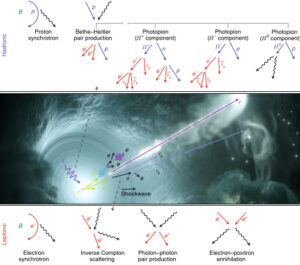
Artistic image illustrating the leptonic and hadronic processes that could occur in the relativistic jets in Blazar. Neutrinos are only produced in the haronic scenario [Image: Pian 2019, Nature Astronomy, 3, 24]
2. Supermassive black hole binaries (galaxy mergers): X-rays and gravitational wave studies.
Multi-messenger astrophysics – combining information from electromagnetic emission, gravitational wave, neutrino and cosmic-ray particles – has emerged over the past decade as a clear-cut discipline providing unique and valuable insights into the physical properties and processes of the Universe.
SInce the first direct detection of stellar-mass compact binary object mergers with the gravitational waves interferometers, LIGO and VIRGO, we now have access to multi-messenger study of these astrophysical sources (physical characteristics and populations).
In 2037, LISA (ESA/L3), the first space-based gravitational wave observatory (mHz), will allow us to probe the mergers of SMBH up to a redshift of about 20.
The two large outstanding missions of ESA, Athena and LISA, will provide for an unprecedented view of SMBH through the Universe history: SMBH seeds, accretion and ejection processes around SMBH during inspiral phase and coalescence, the mass and spin value of SMBH with a remarkable accuracy of 1%. Since 2018, the GECO team has been part of the scientific preparation of the LISA mission and the development of the synergies between Athena and LISA.
- AGN as possible site of production of neutrinos and cosmic-rays
-
Tidal disruption events: A temporary reactivation of SMBH
Most of present SMBH in the central regions of galaxies are said to be dormant or quiescent. They lack matter in their vicinity and therefore cannot emit any electromagnetic signals, contrary to AGN. However, these objects can become active again when the trajectory of a star crosses them within their tidal radius, providing them enough accreting matter to reveal their presence. This exceptional influx of matter produces an intense electromagnetic emission, which can last several months, the time it takes for all the debris to be digested by the SMBH, the so-called Tidal Disruption Event (TDE).
Artist’s representation of a tidal disruption event (a star being torn apart by a black hole). [Image: NASA/CXC/M. Weiss]
